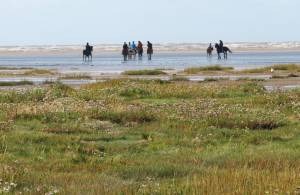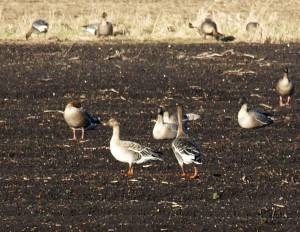Dr Phil Smith’s Wildlife Notes
December 2008
A mostly quiet month, the coldest December for forty years was enlivened by an unusually large flock of 40-50 Twite on the shore opposite Weld Road, Birkdale. These upland finches, closely related to the Linnet, are identified by their buffy faces, yellow bills and distinctive call. This bird is Red-listed as a Species of Conservation Concern in Britain, its Lancashire breeding population having seriously declined in recent years to an estimated 30 pairs, mostly near Burnley. Here, and elsewhere in the south Pennines, feeding stations have been set up to supplement the natural foods that are limited by farming practices. There has also been a programme of colour-ringing so that movements away from the breeding areas can be followed. Surprisingly, these studies show that most Pennine Twite winter in eastern England on salt-marshes from Lincolnshire to Kent, while those resorting to our northwestern shores mainly nest in Scotland, especially the Hebrides. This interesting story is told in more detail in the recently published book “Birds of Lancashire and north Merseyside”.

As usual, the RSPB reserve at Marshside was home to great numbers of waterfowl during the month. An organised count by volunteers on 15th found, just for starters, 9200 Wigeon, 2081 Teal, 1425 Golden Plover, 1976 Lapwings and 2245 Black-tailed Godwits. A further 9000 Wigeon were on the tidal salt-marsh nearby. An American Green-winged Teal was also visible from the hides on some days. Birds of prey on the salt-marsh included up to two Short-eared Owls and Peregrine, Merlin, Marsh Harrier and Hen Harrier, two silvery-grey males of the latter species being spotted from the coastal road.
Unfortunately, this magnificent raptor is less often seen these days, a recent Natural England report drawing attention to its continuing illegal persecution on English grouse-moors during the Harrier’s breeding season and even the suspicious “disappearance” of several satellite-tagged individuals in the north Pennines during winter. The report estimates there should be about 200 pairs of Hen Harriers in England but only 23 pairs attempted to nest in 2007, the majority in Bowland, Lancashire, where they are well-protected by the land-owners working with conservation bodies. Elsewhere, despite legal protection since 1952, Harriers are killed because they feed on Red Grouse and may reduce shooting bags. Some scientists consider there is little chance of this conflict being resolved because of the entrenched attitudes of hunters and conservations, neither group being prepared to compromise. One suggestion is to set local ceilings on Harrier densities, translocating excess birds to other areas of suitable habitat. However, the feasibility of this has yet to be researched and there would be legal barriers to overcome.
Other bird highlights in December included two Bean Geese with Pink-footed Geese near Fine Jane’s Pumping Station reported by Derek Williams, three Snow Buntings on Southport beach which I saw on 18th and about 20 Crossbills at Fisherman’s Path, Ainsdale National Nature Reserve on 28th. Although larger groups have been recorded in the past, this is the most I have seen in the pinewoods in forty years. Finally, we should be looking out for Waxwings, flocks of which have been widely reported on bearing-bearing shrubs in north, central and east Lancashire, but not as yet locally.

